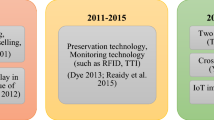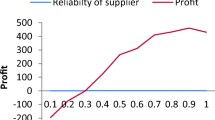Abstract
Inventory control is one of the most critical issues in corporate management. Many mathematical models have been developed to optimize control strategies for the companies’ inventory. Economic production quantity (EPQ) is one of the classic models for inventory control, which is widely used. To deal with the uncertainty in the real world, we need to develop new and useful models for modeling systems of inventory management. In such cases, fuzzy models play a unique role in the field of inventory management. The main contribution of this study is to apply some well-known metaheuristic to solve an extended EPQ model based on fuzzy numbers considering multiple deliveries. This study aims to develop an EPQ model by considering demand as triangular fuzzy numbers and multiple deliveries (delivering in multiple packages) and by considering limitations in warehouse space as well as the total number of orders. Given these conditions, EPQ costs are calculated, and new modeling is presented. The obtained fuzzy model has been simplified by using the \( \alpha{\text{-cut}} \) and changing the variables, and finally, the most well-known metaheuristic algorithms, GA, PSO, GWO, and ICA, are applied in different problem sizes, and obtained results are analyzed in terms of minimizing cost function and CPU time. The result of this paper shows that GWO has superior performance in terms of various parameters.













Similar content being viewed by others
References
Abu Arqub O (2017) Adaptation of reproducing kernel algorithm for solving fuzzy Fredholm–Volterra integrodifferential equations. Neural Comput Appl 28(7):1591–1610
Abu Arqub O et al (2016) Numerical solutions of fuzzy differential equations using reproducing kernel Hilbert space method. Soft Comput 20(8):3283–3302
Arqub OA et al (2017) Application of reproducing kernel algorithm for solving second-order, two-point fuzzy boundary value problems. Soft Comput 21(23):7191–7206
Atashpaz Gargari E et al (2008) Colonial competitive algorithm. Int J Intell Comput Cybern 1(3):337–355
Bag S, Chakraborty D, Roy AR (2009) A production inventory model with fuzzy random demand and with flexibility and reliability considerations. Comput Ind Eng 56(1):411–416
Birjandi AK et al (2019) Evaluation and selecting the contractor in bidding with incomplete information using MCGDM method. Soft Comput 23:10569–10585
Björk K-M (2012) A multi-item fuzzy economic production quantity problem with a finite production rate. Int J Prod Econ 135(2):702–707
Chakrabortty S, Pal M, Nayak PK (2013) Intuitionistic fuzzy optimization technique for Pareto optimal solution of manufacturing inventory models with shortages. Eur J Oper Res 228(2):381–387
Chang P-T, Chang C-H (2006) An elaborative unit cost structure-based fuzzy economic production quantity model. Math Comput Model 43(11–12):1337–1356
Chen SH, Chang SM (2008) Optimization of fuzzy production inventory model with unrepairable defective products. Int J Prod Econ 113(2):887–894
Coello Coello CA (2002) Theoretical and numerical constraint-handling techniques used with evolutionary algorithms: a survey of the state of the art. Comput Methods Appl Mech Eng 191(11–12):1245–1287
Das D, Roy A, Kar S (2011) A volume flexible economic production lot-sizing problem with imperfect quality and random machine failure in fuzzy-stochastic environment. Comput Math Appl 61(9):2388–2400
De SK, Sana SS (2014) A multi-periods production–inventory model with capacity constraints for multi-manufacturers—a global optimality in intuitionistic fuzzy environment. Appl Math Comput 242:825–841
De SK, Sana SS (2018) The (p, q, r, l) model for stochastic demand under Intuitionistic fuzzy aggregation with Bonferroni mean. J Intell Manuf 29(8):1753–1771
De Sujit K (2018) Two-layer supply chain model for Cauchy-type stochastic demand under fuzzy environment. Int J Intell Comput Cybern 11(2):285–308
Eberhart R, Kennedy J (1995) A new optimizer using particle swarm theory. In: Proceedings of the 6th international symposium on micro machine and human science, 1995. MHS’95
Emary E et al (2015) Feature subset selection approach by gray-wolf optimization. In: A Abraham, P Krömer, V Snasel (eds) Afro-European conference for industrial advancement: proceedings of the 1st international Afro-European conference for industrial advancement AECIA 2014. Springer, Cham, pp 1–13
Fattahi P, Hajipour V, Nobari A (2015) A bi-objective continuous review inventory control model: pareto-based meta-heuristic algorithms. Appl Soft Comput 32:211–223
Gen M, Cheng R (1997) Foundations of genetic algorithms. In: Genetic algorithms and engineering design. Wiley Publication, pp 1–432. ISBN: 978-0-471-12741-3
Ghasemy Yaghin R, Fatemi Ghomi SMT, Torabi SA (2013) A possibilistic multiple objective pricing and lot-sizing model with multiple demand classes. Fuzzy Sets Syst 231:26–44
Halim KA, Giri BC, Chaudhuri KS (2009) Fuzzy EPQ models for an imperfect production system. Int J Syst Sci 40(1):45–52
Harris FW (1990) How many parts to make at once. Oper Res 38(6):947–950
Haupt RL, Haupt SE (2004) Practical genetic algorithms. Wiley, Hoboken
Hsieh CH (2002) Optimization of fuzzy production inventory models. Inf Sci 146(1–4):29–40
Hu J-S et al (2010) Optimal production run length with imperfect production processes and backorder in fuzzy random environment. Comput Ind Eng 59(1):9–15
Islam S, Roy TK (2006) A fuzzy EPQ model with flexibility and reliability consideration and demand dependent unit production cost under a space constraint: a fuzzy geometric programming approach. Appl Math Comput 176(2):531–544
Islam S, Roy TK (2007) Fuzzy multi-item economic production quantity model under space constraint: a geometric programming approach. Appl Math Comput 184(2):326–335
Jana DK et al (2013) A fuzzy simulation via contractive mapping genetic algorithm approach to an imprecise production inventory model under volume flexibility. J Simul 7(2):90–100
Jayakumar N et al (2016) Grey wolf optimization for combined heat and power dispatch with cogeneration systems. Int J Electr Power Energy Syst 74:252–264
Kumar RS, Goswami A (2015a) EPQ model with learning consideration, imperfect production and partial backlogging in fuzzy random environment. Int J Syst Sci 46(8):1486–1497
Kumar RS, Goswami A (2015b) A fuzzy random EPQ model for imperfect quality items with possibility and necessity constraints. Appl Soft Comput 34:838–850
Kumar RS, Goswami A (2015c) A continuous review production–inventory system in fuzzy random environment: minmax distribution free procedure. Comput Ind Eng 79:65–75
Kuo RJ, Han YS (2011) A hybrid of genetic algorithm and particle swarm optimization for solving bi-level linear programming problem—a case study on supply chain model. Appl Math Model 35(8):3905–3917
Lee H-M, Yao J-S (1998) Economic production quantity for fuzzy demand quantity, and fuzzy production quantity. Eur J Oper Res 109(1):203–211
Lin D-C, Yao J-S (2000) Fuzzy economic production for production inventory. Fuzzy Sets Syst 111(3):465–495
Mahapatra NK, Maiti M (2006) Production–inventory model for a deteriorating item with imprecise preparation time for production in a finite time horizon. Asia Pac J Oper Res 23(02):171–192
Mahapatra GS, Mandal TK, Samanta GP (2011) A production inventory model with fuzzy coefficients using parametric geometric programming approach. Int J Mach Learn Cybern 2(2):99–105
Mahata GC (2017) A production-inventory model with imperfect production process and partial backlogging under learning considerations in fuzzy random environments. J Intell Manuf 28:883–897
Maity K, Maiti M (2007) Possibility and necessity constraints and their defuzzification—a multi-item production-inventory scenario via optimal control theory. Eur J Oper Res 177(2):882–896
Maity AK, Maity K, Maiti M (2008) A production–recycling–inventory system with imprecise holding costs. Appl Math Model 32(11):2241–2253
Mandal NK, Roy TK (2006) A displayed inventory model with L-R fuzzy number. Fuzzy Optim Decis Making 5(3):227
Mandal NK, Roy TK, Maiti M (2005) Multi-objective fuzzy inventory model with three constraints: a geometric programming approach. Fuzzy Sets Syst 150(1):87–106
Mandal S et al (2011) Multi-item multi-period optimal production problem with variable preparation time in fuzzy stochastic environment. Appl Math Model 35(9):4341–4353
Mezei J, Björk K-M (2015) An economic production quantity problem with backorders and fuzzy cycle times. J Intell Fuzzy Syst 28(4):1861–1868
Mirjalili S (2015) The ant lion optimizer. Adv Eng Softw 83:80–98
Mirjalili S (2016) SCA: a sine cosine algorithm for solving optimization problems. Knowl Based Syst 96:120–133
Mirjalili S, Mirjalili SM, Lewis A (2014) Grey wolf optimizer. Adv Eng Softw 69:46–61
Mondal M et al (2013) A production-repairing inventory model with fuzzy rough coefficients under inflation and time value of money. Appl Math Model 37(5):3200–3215
Mondal M, Maiti MK, Maiti M (2014) A two storage production-repairing model with fuzzy defective rate and displayed inventory dependent demand. Optim Eng 15(3):751–772
Mousavi SM et al (2013) Optimizing multi-item multi-period inventory control system with discounted cash flow and inflation: two calibrated meta-heuristic algorithms. Appl Math Model 37(4):2241–2256
Mousavi SM et al (2016) A bi-objective inventory optimization model under inflation and discount using tuned Pareto-based algorithms: NSGA-II, NRGA, and MOPSO. Appl Soft Comput 43:57–72
Nazari-Shirkouhi S et al (2010) Solving the integrated product mix-outsourcing problem using the imperialist competitive algorithm. Expert Syst Appl 37(12):7615–7626
Pal S, Maiti MK, Maiti M (2009) An EPQ model with price discounted promotional demand in an imprecise planning horizon via Genetic Algorithm. Comput Ind Eng 57(1):181–187
Pal S, Mahapatra GS, Samanta GP (2014) An EPQ model of ramp type demand with Weibull deterioration under inflation and finite horizon in crisp and fuzzy environment. Int J Prod Econ 156:159–166
Pal S, Mahapatra GS, Samanta GP (2015) A production inventory model for deteriorating item with ramp type demand allowing inflation and shortages under fuzziness. Econ Model 46:334–345
Panda D, Maiti M (2009) Multi-item inventory models with price dependent demand under flexibility and reliability consideration and imprecise space constraint: a geometric programming approach. Math Comput Model 49(9–10):1733–1749
Pappis CP, Karacapilidis NI (1995) Lot size scheduling using fuzzy numbers. Int Trans Oper Res 2(2):205–212
Pasandideh SHR, Niaki STA (2008) A genetic algorithm approach to optimize a multi-products EPQ model with discrete delivery orders and constrained space. Appl Math Comput 195(2):506–514
Paul SK et al (2014) Development of a production inventory model with uncertainty and reliability considerations. Optim Eng 15(3):697–720
Porteus EL (1990) Chapter 12 Stochastic inventory theory. In: Handbooks in operations research and management science, Vol 2. Elsevier Publication, Hoboken, pp 605–652
Sadeghi J et al (2016) Optimising multi-item economic production quantity model with trapezoidal fuzzy demand and backordering: two tuned meta-heuristics. Eur J Ind Eng 10(2):170–195
San-Chyi C (1999) Fuzzy production inventory for fuzzy product quantity with triangular fuzzy number. Fuzzy Sets Syst 107(1):37–57
Shekarian E et al (2014a) A fuzzified version of the economic production quantity (EPQ) model with backorders and rework for a single-stage system. Eur J Ind Eng 8(3):291–324
Shekarian E et al (2014b) Optimal manufacturing lot size for a single-stage production system with rework in a fuzzy environment. J Intell Fuzzy Syst 27(6):3067–3080
Shekarian E et al (2017) Fuzzy inventory models: a comprehensive review. Appl Soft Comput 55:588–621
Sulaiman MH et al (2015) Using the gray wolf optimizer for solving optimal reactive power dispatch problem. Appl Soft Comput 32:286–292
Takami MA, Sheikh R, Sana SS (2018) A hesitant fuzzy set theory based approach for project portfolio selection with interactions under uncertainty. J Inf Sci Eng 34(1):65–79
Wang X, Tang W (2009a) Optimal production run length in deteriorating production processes with fuzzy elapsed time. Comput Ind Eng 56(4):1627–1632
Wang X, Tang W (2009b) Fuzzy EPQ inventory models with backorder. J Syst Sci Complex 22(2):313–323
Yadav D, Pundir S, Kumari R (2010) A fuzzy multi-item production model with reliability and flexibility under limited storage capacity with deterioration via geometric programming. Int J Math Oper Res 3(1):78–98
Yu JJQ, Li VOK (2015) A social spider algorithm for global optimization. Appl Soft Comput 30:614–627
Zhang C, Zhao R, Tang W (2009) Optimal run lengths in deteriorating production processes in random fuzzy environments. Comput Ind Eng 57(3):941–948
Ziukov S (2015) A literature review on models of inventory management under uncertainty. Verslo Sistemos ir Ekonomika 5(1):26–35
Funding
The study is not funded by any agency.
Author information
Authors and Affiliations
Corresponding author
Ethics declarations
Conflict of interest
The authors do hereby declare that there is no conflict of interest of other works regarding the publication of this paper.
Human and animal rights
This article does not contain any studies with human participants or animals performed by any of the authors.
Additional information
Communicated by V. Loia.
Publisher's Note
Springer Nature remains neutral with regard to jurisdictional claims in published maps and institutional affiliations.
Rights and permissions
About this article
Cite this article
Moghdani, R., Sana, S.S. & Shahbandarzadeh, H. Multi-item fuzzy economic production quantity model with multiple deliveries. Soft Comput 24, 10363–10387 (2020). https://doi.org/10.1007/s00500-019-04539-6
Published:
Issue Date:
DOI: https://doi.org/10.1007/s00500-019-04539-6




